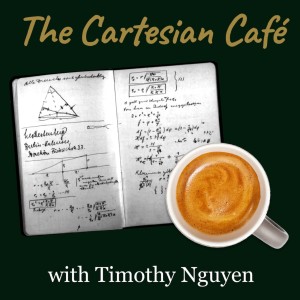
Wednesday Sep 07, 2022
John Baez | The Algebra of Grand Unified Theories
John Baez is a mathematical physicist, professor of mathematics at UC Riverside, a researcher at the Centre for Quantum Technologies in Singapore, and a researcher at the Topos Institute in Berkeley, CA. John has worked on an impressively wide range of topics, pure and applied, ranging from loop quantum gravity, applications of higher categories to physics, applied category theory, environmental issues and math related to engineering and biology, and most recently on applying network theory to scientific software.Additionally, John is a prolific writer and blogger. This first began with John’s column This Week's Finds in Mathematical Physics, which ran 300 issues between 1993 and 2010, which then continued in the form of his ongoing blog Azimuth. Last but not least, John is also a host and contributor of the popular blog The n-category Cafe.
Patreon: https://www.patreon.com/timothynguyen
Correction:
- 1:29:01: The formula for hypercharge in the bottom right note should be Y = 2(Q-I_3) instead of Y = (Q-I_3)/2.
Notes:
- While we do provide a crash course on SU(2) and spin, some representation theory jargon is used at times in our discussion. Those unfamiliar should just forge ahead!
- We work in Euclidean signature instead of Lorentzian signature. Other than keeping track of minus signs, no essential details are changed.
Part I. Introduction
- 00:00: Introduction
- 05:50: Climate change
- 09:40: Crackpot index
- 14:50: Eric Weinstein, Brian Keating, Geometric Unity
- 18:13: Overview of “The Algebra of Grand Unified Theories” paper
- 25:40: Overview of Standard Model and GUTs
- 34:25: SU(2), spin, isospin of nucleons 40:22: SO(4), Spin(4), double cover
- 44:24: three kinds of spin
Part II. Zoology of Standard Model
- 49:35: electron and neutrino
- 58:40: quarks
- 1:04:51: the three generations of the Standard Model
- 1:08:25: isospin quantum numbers
- 1:17:11: U(1) representations (“charge”)
- 1:29:01: hypercharge
- 1:34:00: strong force and color
- 1:36:50: SU(3)
- 1:40:45: antiparticles
Part III. SU(5) numerology
- 1:41:16: 32 = 2^5 particles
- 1:45:05: Mapping SU(3) x SU(2) x U(1) to SU(5) and hypercharge matching
- 2:05:17: Exterior algebra of C^5 and more hypercharge matching
- 2:37:32: SU(5) rep extends Standard Model rep
Part IV. How the GUTs fit together
- 2:41:42: SO(10) rep: brief remarks
- 2:46:28: Pati-Salam rep: brief remarks
- 2:47:17: Commutative diagram: main result
- 2:49:12: What about the physics? Spontaneous symmetry breaking and the Higgs mechanism
Twitter: @iamtimnguyen
Webpage: http://www.timothynguyen.org
No comments yet. Be the first to say something!